
RENAULT Megane Estate
Generations Timeline, Specs and Pictures
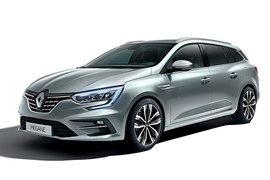
The french manufacturer broke the silence in the beginning of 2020 with the introduction of the new, face-lifted generation of its top-seller in the compact range, the Megane.
The biggest improvements are on the tech-department, which are added to a slightly modified bodywork.
On the outside, the new Megane was improved with a new pair of headlights, which received LED technology for better visibility. The plug-in estate version has a 434 liter trunk-space (15.3 cu-ft), 84-liters (3 cu-ft) less than the non-hybrid versions.
Renault was at the forefront of electric mobility in Europe. The French carmaker hase a line-up of electric vehicles ranging from the two-seater Twizy up to the light commercial vehicles. Now it made a bold move into the plug-in hybrid (PHEV) technology, two years after buying Mitsubishi Motors, who already had this technology in production. The Renault Megane E-TECH plug-in hybrid can run 65 km (40 miles) purely electric in the mixed cycle or 50 km (31 miles) in urban environment (according to the WLTP cycle).
The face-lifted Megane will lose the GT-Line trim, which has been replaced with the new RS-Line badge. Compared with the GT-Line, the new trim will have a sportier look both on the inside and on the outside of the vehicle.
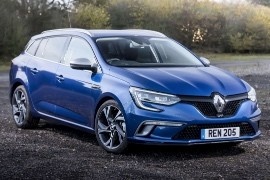
Renault introduced the fourth generation of the Megane Estate in 2016 and, apart from the rest of the range, it prepared a special trim level: the GT.
There was more than just a special color, rims, and aero package on the Megane Estate. The Megane Estate GT was the sporty station-wagon that could carry all the needs for a family but still be driven hard and offer plenty of pleasure for the one behind the wheel.
A surrounding daytime running light encircled the headlights, and that gave the car a distinctive personality. But that was not enough for the French carmaker that employed the Renault Sport division to somehow transform the station-wagon. The Dieppe crew worked on the front bumper and installed a new one with a different design for the lower side, where they added a lip to reduce the ground effect. Two grilles were placed on the exterior to mimic air-scoops for the brakes, where they put the fog lights. A mandatory roof-spoiler extended the roofline and made the airflow cleaner behind the car. There was nothing installed just for the look.
The interior revealed a different character of the car, with sculptured bucket seats for the front occupants. A big R-Link infotainment system was installed on the center stack. Next to the gear-selector, a special button with a flag showed started to raise questions about the car’s character.
The drivetrain was different than the rest of the Megane Estate range. A 4-wheel steering system was installed, which helped the car get faster around the corners. The GT featured a standard, 6- or 7-speed automatic (dual-clutch) transmission with paddle shifters (depending n the engine). The launch-control mode was standard as well.

The 2016 Renault Megane Estate returned on the market with the true intention to get more out of the station wagon segment.
It started with a good platform, a good engine choice, and a decent price.
Renault managed to offer estate versions for almost all of its lineup. The French can be trusted when they are building cars for families. The Megane Estate is a good example. A nice design, with lots of curved surfaces, a nice interior and enough technology to satisfy the driver.
The R-Link 2 unit featured a portrait-type touchscreens TFT display in the central console. It had various features and a rotating-knob controller placed between the front seats. Other features available for the car were the automatic climate control system with a pollution analyzer. It could get a touch of luxury with leather seats. It also has great scores in safety tests.
The engine choice is extensive, ranging from 90 hp up to 205 hp, with good offers regarding both gasoline or diesel units. A choice of manual and dual-clutch transmission was available too. Moreover, it had an optional four-wheel-steering, which was unusual for the compact-car segment.
Inside, the room was large enough for five people and a big, 580 liters (20.5 cu-ft) trunk space, with the rear seats up. With the seats down, the total loading length was 2.7 meters (8.8 ft).
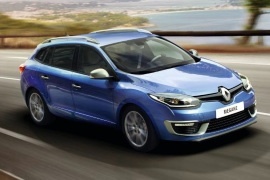
The refreshed Renault Megane lineup got revealed in September 2013 at the Frankfurt Motor Show, being available as a hatchback, estate and coupe.
They all have the same new face, but manage to get pretty distinctive with the rest of the styling. The front gets new elliptical headlights as well as some bigger bonnet and bumper sections, which brings more of the Fluence look into the scenery. New things inside include the Renault R-Link multimedia system, better materials and some refined shapes. Under the hood you’ll also find a brand new 1.2-liter gasoline unit making 130 hp mated to the EDC automatic transmission.

Renault unveiled the third generation of its compact-segment range in late 2008 and, in 2009, it introduced the station-wagon version.
The compact segment was rising again after the world financial crisis, and Renault rushed to offer a complete lineup for the successful Megane nameplate. While some customers were eager to get their hands on the beautiful three-door version, the station-wagon was the choice of families and salesmen across the European continent. It was a decent vehicle, good and practical.
Renault dropped the original idea of a classic station wagon with a wide window behind the rear doors. The overall look was closer to a hatchback with a longer roof. At the front, it used the same front fascia with swept-back headlights on the fenders, and the grille was installed only in the front apron, not above the bumper. From its sides, the turn-signals on the mirrors and the body-colored door handles were fitted as standard.
Inside, Renault installed a curved dashboard covered in a soft material. Its instrument cluster sported a digital speedometer in the middle flanked by an analog tachometer on the left and a smalls LCD for the on-board computer on the right. In the middle of the dash panel, an additional cluster featured an additional display for the audio system, showing the caller-ID information or other relevant data from the radio or the CD-player. The Megane’s interior was fit for up to five adults, with two, almost flat, seats at the front and a split-folding bench in the back. The user could have expanded the trunk area from its regular 524 liters (18.5 cu-ft) up to 1,595 liters (56.33 cu-ft).
Renault offered the Megane with up to 14 engine choices, with automatic or CVT transmissions, depending on the market.
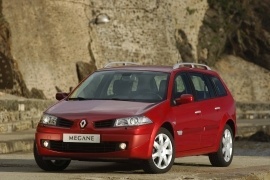
The French carmaker introduced a refreshed version of the Megane’s second generation in 2006 for the entire range, including the station wagon.
After a successful first-generation, Renault was ready to get more customers with the Megane sequel on the European market. That’s why it tried improving the car in all the areas, and especially on the safety side, where the car got a five-star rating in the EuroNCAP crash tests.
The facelifted version of the Megane Station Wagon got a new front fascia, with body-colored plastic moldings over the bumpers and sides, which were black on the 2003 version. The carmaker installed the same angular headlights that were continued on the same line with the black grille. On the lower side of the front bumper, the carmaker installed round fog lights as standard for the entire range.
The interior showed a new navigation system designed together with TomTom. Its retractable screen on top of the dashboard was unique on the market, at least on the budget car segment. Like its predecessor, it featured a 60/40 split bench in the rear, which increased the trunk size from 520 (18.4 cu-ft) liters to 1,600 liters (56.5 cu-ft).
Under the hood, Renault installed a choice of seven engines, both gasoline, and turbo-diesel. It was available exclusively with a manual gearbox.

The Renault Megane Estate was refreshed in 2003 when the car model received almost the same improvements as the contemporary basic Megane.
The front was redesigned in order to match the same design line as the other Renault models, with a grille divided into two parts in order to encircle the badge. The headlights and the front bumper have also been redesigned, providing a more modern and stylish look. New engines were also introduced, including a 1.9 dCi producing 130 horsepower which is now the top engine in this series. This engine can help the car reach a top speed of 200 km/h with a 0 to 100 km/h acceleration in 9.3 seconds.
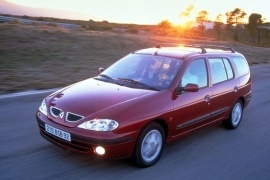
The Renault Megane Estate is the station wagon variant of Renault Megane which was first unveiled in 1999.
Obviously a more spacious version of the car, the Megane Estate is also called Sport Tourer and Grandtour, depending on the manufacturer and on the market area. The engine configurations are different from the ones installed on the basic Megane, powered by both diesel and petrol. The top engine of the Estate is the 1.8-liter 16V which develops 115 horsepower and a top speed of 123.7 mph. This Estate version was manufactured until 2003 when the French carmaker brought out a new and upgraded Estate.























































